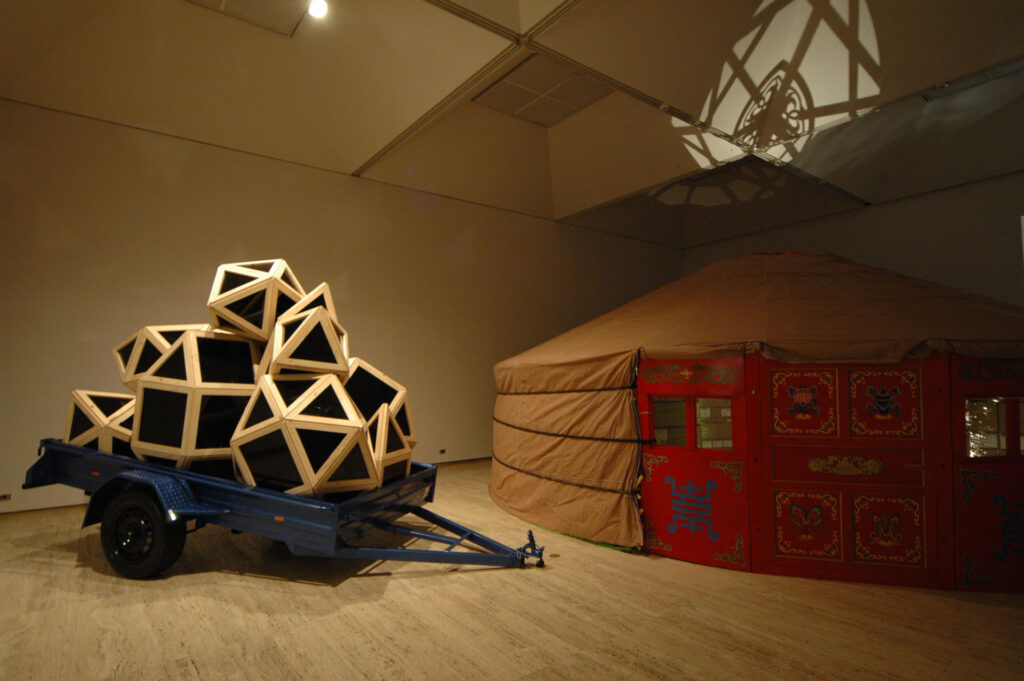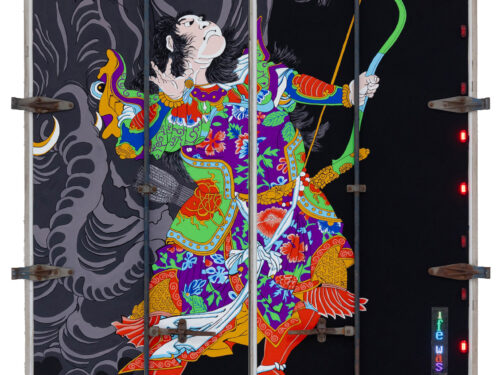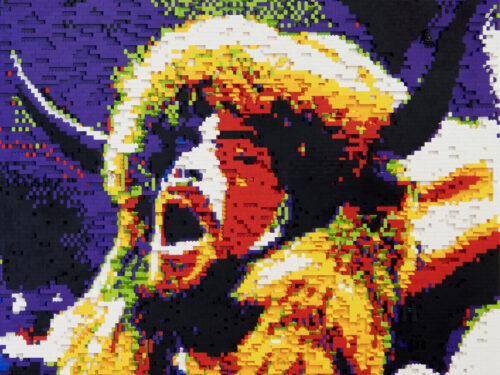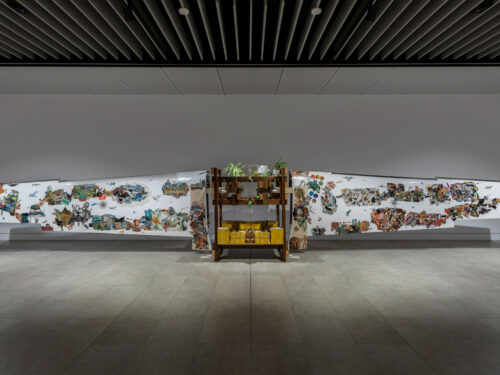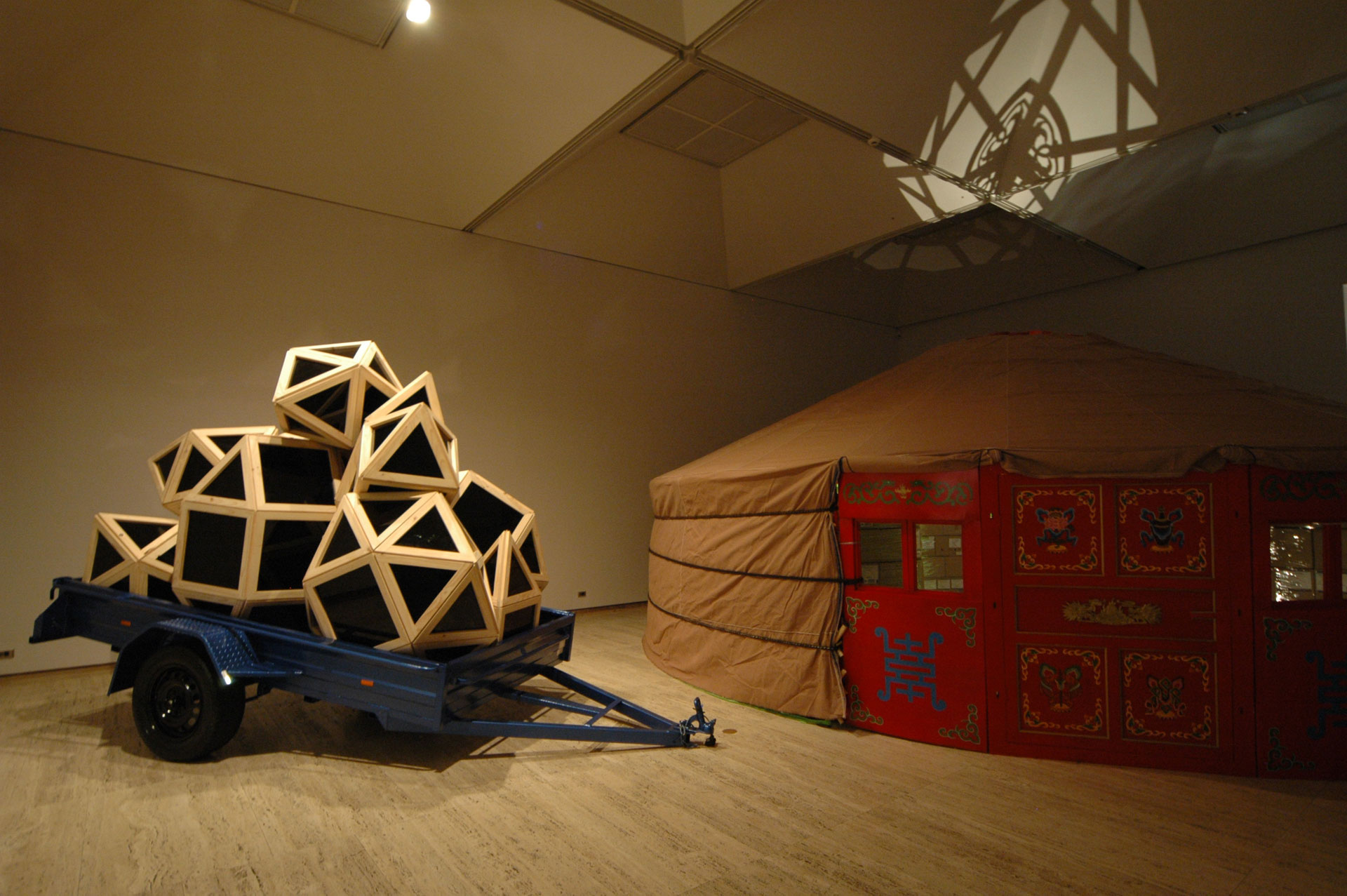
The Paper Trail
FOLLOWING THE PAPER TRAIL
words by Soda_Jerk
The territory of an artwork cannot be mapped. What we offer here is a single path through The Paper Trail, pieced together from the bits of paper that guided our way.
Document 1: Email correspondence with the artists [viewed 28/05/07]
The first we heard about The Paper Trail came in an email from the artists earlier this year. The ultimate form that the installation would take had not yet been formulated but Sean Cordeiro and Claire Healy were sure of one thing: there would be a yurt in it. At some stage in high school we’d learnt that a yurt was a form of transportable shelter used in nomadic societies. It could be assembled quickly and was suitable for a wide range of climate conditions. As mobile dwellings such as caravans have often featured in Sean and Claire’s work, the fact that the artists were keen to work with such a structure came as no surprise.
Document 2: A magazine article [viewed 28/05/07]
The idea that the artists were interested in utilising nomadic architecture reminded us of an Australian Art Collector that had been sitting under our coffee table. In an excellent article titled ‘Home and Away,’ Edward Colless connects the nomadic travel habits of Sean and Claire with the globalisation of the art market by arguing that “the proliferation of international arts residency programs over the past decade or so has generated a population of subsidised career transients.”1 But for Colless what distinguishes Sean and Claire from other nomadic art professionals is that their nomadism is not simply a way of reaching an international market, but also a key conceptual concern of their practice. On this point he receives back-up from Sean: “Our art is about spaces of transit, where you cross between territories.”
Document 3: The installation floor plan [viewed 24/06/07]
We had been tipped off that Sean and Claire were researching the Mongol Empire and had settled on a ger (Mongolian for yurt) for their proposed installation. And yet when the floor plan arrived in our inbox, our limited knowledge of Mongolian history had left us wholly unprepared for the presence of so many filing cabinets. Just what was this fixture of the Western corporate office doing inside a dwelling utilized by barbarian nomads from the 13th and 14th century?
Document 4: A Wikipedia entry [viewed 24/06/07]
A brief Wikipedia search made it clear that the proliferation of filing cabinets was not so incongruous with Mongolian history after all2. In fact, the Mongol Empire was characterised by a high level of bureaucracy; ruling not only through military intimidation but also administrative force. After a city had been conquered, clerks were instructed to arrange the population by profession in order for their knowledge and expertise to be mobilised by the Empire. A detailed stock take of the city’s valuables was also taken so that the spoils could be evenly distributed amongst the conquering army. Of course procedures such as these required vast documentation, and paper became a key resource for the Mongols—so much so that in 1221 the Empire demanded that Korea present them with one hundred thousand sheets of paper.
Document 5: Reference books [viewed 07/07/07]
However, tracking the significance of paper to the Mongol Empire is not only a matter of volume but also of distribution. More than 200 years before Gutenberg’s press, the Mongol’s had revolutionised printing by adapting Chinese print technology to incorporate their phonetic alphabet. This development sped up the process immeasurably by eliminating the need to carve the entire text from scratch3. Combined with the efficient transport networks that connected the Empire, this generated optimum conditions for the mass dissemination of information – a fact that would be of interest to Paul Virilio who has argued that “[p]ossession of territory is not primarily about laws and contracts, but first and foremost a matter of movement and circulation.”4 While the textbook account of the “evolution” of a society posits a flow from nomadism-agarianism-suburbanisation-industrialisation-globalism, the paper trail of the Mongol Empire would seem to suggest a link between the distributed networks of nomadism and contemporary globalism.
Document 6: A mathematics webpage [viewed 30/06/07]
None of this, however, appeared to account for the stunning mirrored forms throughout the artist’s installation. Labelled “Johnson Solids” on the floor plan, we typed the term into a search engine, half expecting to unearth a rare gem or traditional Mongolian relic. Instead we discovered the following definition: “In geometry a Johnson Solid is a strictly convex polyhedron, each face of which is a regular polygon, which is not a Platonic solid, Archimedean solid, prism, or antiprism. There is no requirement that each face must be the same polygon, or that the same polygons join around each vertex.”5 The fact that a Johnson Solid is a form consisting of an irregular combination of shapes recalled a passage we had read in Jack Weatherford’s text Genghis Kahn and Making of the Modern World (2004).
Document 7: A reference book [viewed 07/07/07]
For Weatherford what is significant about the culture of the Mongol Empire is that it was essentially a conglomeration of influences. He argues that “because they had no system of their own to impose on their subjects, they were willing to adopt and combine systems from everywhere… They searched for what worked best and when they found it, they spread it to other countries.”6 So while the Mongols are credited with very few inventions, they were undoubtedly responsible for facilitating an environment where disparate ideas and cultures could be combined into new constellations. “The Mongol armies destroyed the uniqueness of the civilisations around them by shattering the protective walls that isolated one civilisation from another and by knotting the cultures together.”7 Interestingly, it’s a quotation that could just as easily function as an assessment of contemporary globalism.
Document 8: An artist statement [viewed 24/06/07]
Of course, what is conspicuously absent from the above paper trail is the very document that initiated the circulation of sources in this text—the artist statement. Sean and Claire conclude with the following: “The conflagration of Nomadism and Globalism challenges our perception of both concepts: removing the perceived purity of nomadism and questioning the sophistication behind globalism.”
- Edward Colless, ‘Home and Away’, Australian Art Collector, Issue 38, Oct-Dec 2006, p109
- http://en.wikipedia.org/wiki/Mongolian_Empire, online: 24/06/07, p1
- Jack Weatherford, Genghis Khan and the Making of the Modern World (Crown, 2004) p232
- Paul Virilio, Pure War (Virilio and Lotringer, 1997 [1983])
- http://mathworld.wolfram.com/JohnsonSolid.html, online: 30/06/07, p1
- Jack Weatherford, Genghis Khan and the Making of the Modern World (Crown, 2004) p234 7 Ibid, p267
The Paper Trail
Words by CH + SC
‘Whoever controls the territory possesses it. Possession of territory is not primarily about laws and contracts, but first and foremost a matter of movement and circulation.’- Virilio
It is little known in the western world that the Mongolian empire was the largest empire in the world, second only to the British Empire. This empire spanned the majority of East Asia and central Europe- 33 million square kilometres. The rise of an empire, from nomadic herdsmen to world conquerors in just one generation is a singular world event.
The Mongol empire is a field worthy for artistic investigation as it illustrates two aspects of theory by Paul Virilio- Dromology and the Integral Accident. The Mongol empire was won on the basis of the swiftness of its army. The empire flourished through the speed of transport and communication between continents. But the empire crumbled because of the black plague that exploited the movement of goods and people within the Pax Mongolica.
Perhaps it is because there are so few inventions or architectural relics created by the Mongolian Empire, that they are considered to be little more than marauding barbarians. Yet, in essence the Mongolians were the first truly global people. After their initial destruction and conquest of cities, the Mongols instituted systems that served to create networks of commerce and communication that spanned continents. They created a global order that was based upon free trade, a reliable postal system, religious freedom, a single international law, a universal alphabet and a paper currency that was to be used everywhere.
Basically the Mongolians were the first global managers. The first evidence of this can be seen in 1221. Genghis Khan had perfected the art of plundering cities. After a city had been conquered, it’s infantry and aristocracy killed, the Mongol officers would send in clerks to arrange the population by profession: people who could write in any language, clerks, doctors, astronomers, judges soothsayers, engineers, teachers, imams, rabbis, priests, people who spoke multiple languages and craftsmen were all integrated into the Mongol juggernaut, adding to the intellectual pool. After this, all objects of value were gathered up and a stock take made. This stock take ensured that all participants in the war received equal share in the plunder and that the families of deceased soldiers were compensated for.
This high level of bureaucracy demanded the use of much paper. This paper was sourced from Korea: in 1221 the Mongols demanded that Korea present one hundred thousand sheets of paper to the Mongol empire. Proof that the Mongolian empire ruled not only through military might but also through administrative force. In 1236 under the reign of Ogodei, the Mongols adapted Chinese printing technology to incorporate the use of their phonetic alphabet; enabling the ability to merely sequence letters on a plate rather than carving whole new texts in order to print documents- this was achieved more than 200 years before Gutenberg’s press.
The Mongolians made culture portable, as a race of nomadic people; they saw no problem in exchanging goods and services throughout the kingdom. The Mongols did not build many cities, but they built many bridges and cleared many roads through the empire: firstly to ensure the swiftness of their armies in war and consequently to facilitate the free movement of goods and people throughout the empire. Under this Pax Mongolica trade flourished until 1332 when the Integral Accident within this system manifested itself.
The Black Plague was able to move swiftly through the empire by its transition from person to person and also through fleas that lived within fabrics and other goods that were traded and rats that lived within trading ships that sailed between cities. In the end, the strength of the Empire: it’s fluidity of movement of people and goods caused this global system to implode into itself.
Concept
Paper Trail is a continuation of our investigation into Nomadism and Globalism. Hitherto we had thought of modern nomadism within the boundaries of gentrification, international labour needs and generation lonely planet.
Our understanding of the relationship between Globalism and traditional Nomadism greatly changed after attending a seminar by Matthew Stadler in relation to the transportation routes established by Native Americans prior to the urbanization of the West, reading Genghis Khan and the Making of the Modern World by Jack Weatherford, Pure War by Paul Virillio and various texts on the Black Plague.
Generally speaking, the concept of the “evolution” of a society flows from nomadism- agrarianism-suburbanisation-industrialisation-globalism. But somehow, in a process similar to that of sublimation (where solid state turns directly into gaseous state, bypassing liquid phase) a culture can transform from nomadic, directly to global.
Genghis Khan adapted the hunting tactics and herding practices he learnt as a nomad on the steeps of Mongolia to create successful battle strategies to consolidate the Mongol nation and to later form the Mongol Empire. The Mongol hordes raised cities and villages in their wake. In doing so they created more grazing land that provided their future armies with more animals to eat and faster roads to ride their horses through. By eliminating the aristocratic class and creating better transport systems, the Mongols created a liberalised economic system.
Two principles that both ideologies share are movement and circulation. The Mongols never invented anything but they did facilitate an environment in which disparate ideas and concepts could be melded together, forming entirely new creations: a process similar to pastiche, remixing or curating…
The conflagration of Nomadism and Globalism challenges our perception of both concepts: removing the perceived purity of nomadism and questioning the sophistication behind Globalism.
